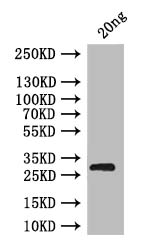To obtain the brat polyclonal antibody, a recombinant Drosophila melanogaster (Fruit fly) brat protein segment (amino acids 294-487) is used as the immunogen to stimulate an antibody response in a rabbit. The serum collected from the rabbit contains polyclonal antibodies, which are subsequently purified using affinity chromatography. The proficiency of the brat antibody in detecting the Drosophila melanogaster (Fruit fly) brat protein is established through ELISA and WB assays, confirming its reliability for experimental applications.
In Drosophila melanogaster (fruit fly), the brat (brain tumor) protein is a crucial regulator of neuroblast differentiation during nervous system development. Functioning as a tumor suppressor, brat plays a pivotal role in orchestrating asymmetric cell division in neuroblasts, ensuring the balanced production of cells with distinct fates. By controlling cell fate determination and preventing uncontrolled proliferation, brat contributes to the formation and maintenance of a properly functioning nervous system.







